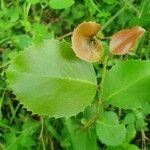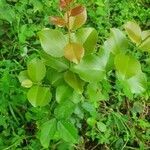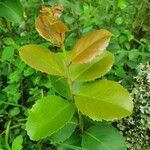Tree or shrub, up to 13 m high, armed or unarmed. Leaves alternate, petiolate; elliptic, ovate or obovate, margins entire or crenate-serrate, teeth usually in upper 1/2; dull green above, paler below, upper surface frequently covered with a thin, flaky, waxy covering, often bright pink when young. Flowers bisexual, axillary racemes. Receptacles funnelshaped. Sepals 5 or 6. Petals when present, narrowly elliptic. Disc fleshy, densely villous. Stamens many. Ovary superior, 1-locular, ovules 4; style simple; stigma bifid, subsessile. Flowering time all year. Fruit a fleshy berry, style persistent.
Shrub or tree, up to 13 m high; armed, spines sometimes form large, branched masses on main trunk. Leaves petiolate; blade narrowly to broadly obovate, sometimes elliptic or ovate, 20-80 x 10-35 mm, base narrowly cuneate, apex acute, margins entire except for a few distantly spaced teeth in upper half of blade, upper surface with a flaky, waxy covering. Flowers: small, sepals ± 1.3-1.5 mm long; inflorescence racemose; perianth white or cream-coloured to yellow, fading to brown; Jun.-Nov., Mar. Fruit a globose berry, up to 9 mm in diameter, red, style persistent.
A spiny shrub or small tree. It can grow to 7 m tall. The bark is light grey and smooth. It becomes dark with age and rough and peeling in flakes. There are usually spines on the small branches. The leaves vary in shape. The can be sword shaped or round. They are 2-8 cm long by 1-3.5 cm wide. The are leathery and dark green above but paler underneath. The flowers are small and white or yellow. The fruit is almost round and a berry. It has a style at the tip. It is about 5-10 mm across.
Like S. mundii but leaves narrower and entire or sparsely toothed, often waxy above.




